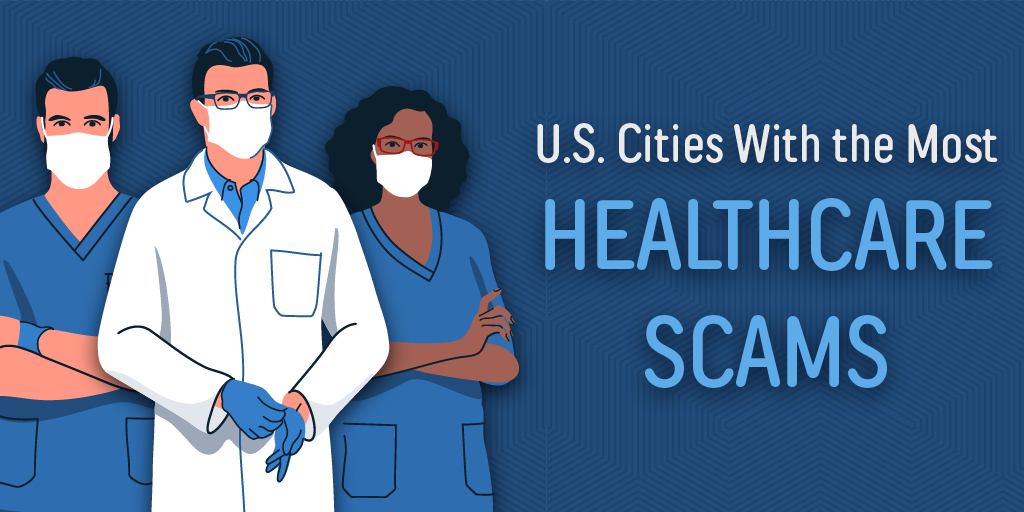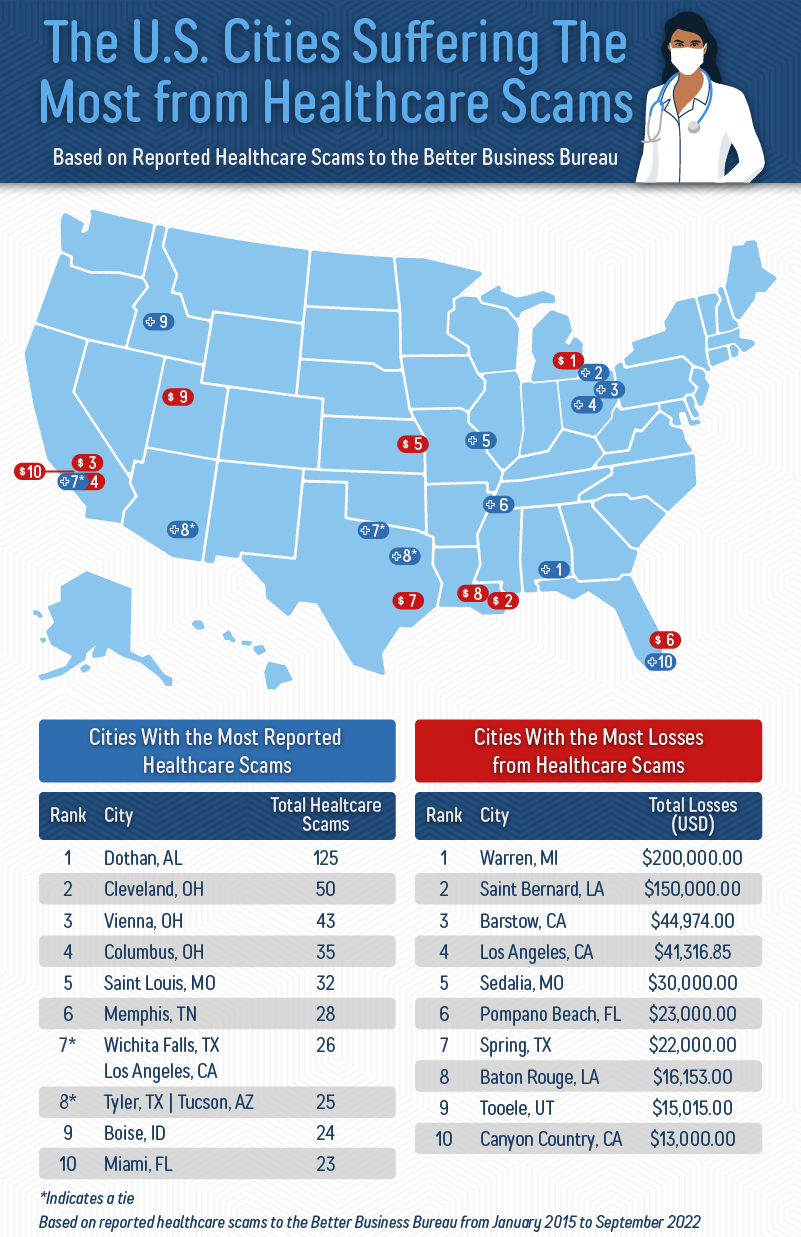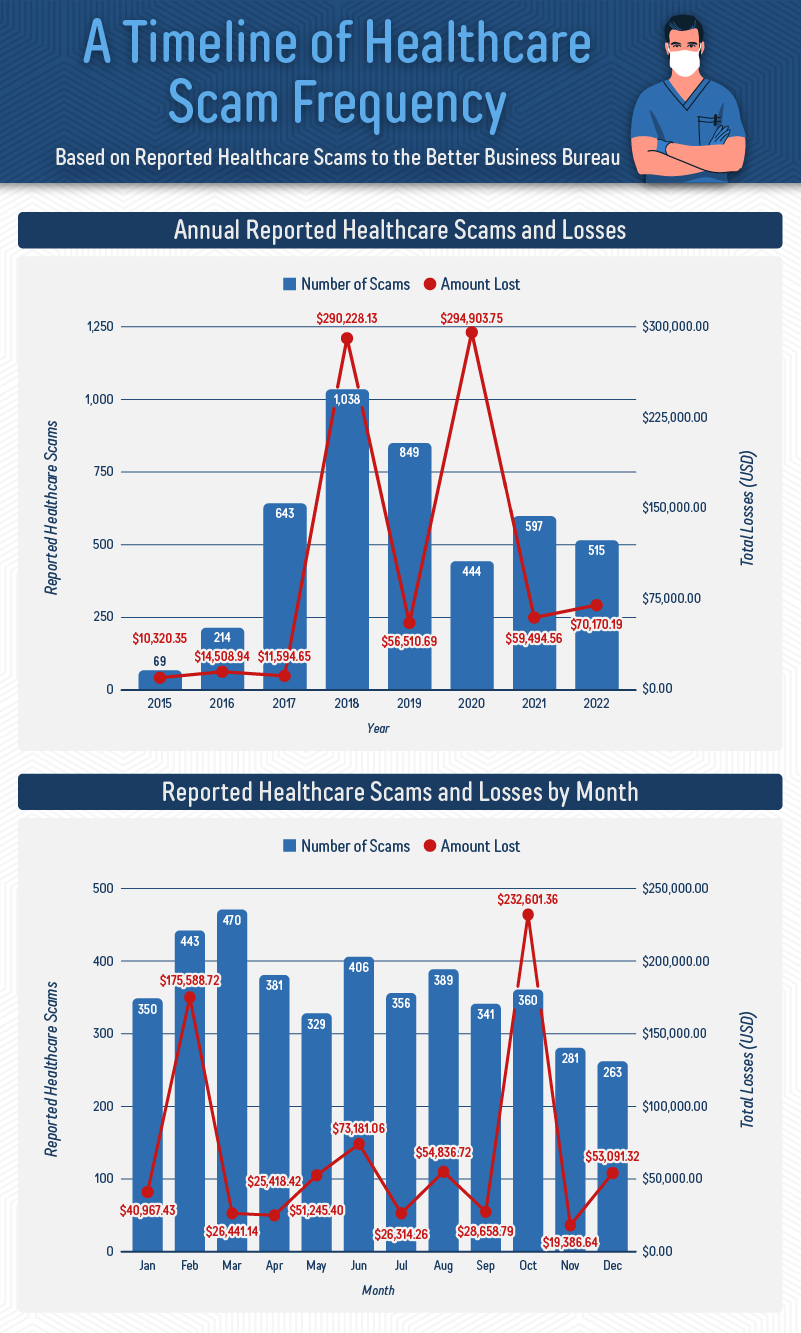Need Help? Call Now
1-800-952-8444Free Consultation
Need Help? Call Now
1-800-952-8444Posted on November 18, 2022

Come open enrollment season, healthcare scams are at the top of everyone’s minds. These typically occur when a scammer calls or sends a message to someone representing themselves as a government agency employee and seeking your medical and/or financial information.
For this study, we used the Better Business Bureau’s data to find areas in the country where people are most likely to fall victim to healthcare scams and to determine how much money was reportedly lost from them. You may be able to better avoid providing valuable information to scammers by understanding how likely it is that one of them will contact you. Read on to learn more about what we found.
Since 2015, over 4,000 Americans across the country have fallen victim to healthcare scammers. During that time, it was reported that over $800,000 was lost to con artists posing as official healthcare providers and/or government officials. On average, healthcare scam victims lost nearly $200 per scam. Some of the most common types of healthcare fraud include bogus marketing, identity theft, and the impersonation of a healthcare provider.
In many cases, healthcare fraud victims were fooled into giving an unauthorized person their private information. Healthcare fraudsters trick people into giving them their personal information in order to charge them for services that were never provided to them. Some scams are more elaborate and costly than others; for example, scammers may even impersonate healthcare professionals and government officials to convince people into enrolling in recurring fake benefit plans.

Three Ohio cities made it into our top ten cities with the most reported healthcare scams, making it the state wherein the most scams are reported overall nationally. Since 2015, nearly 400 Ohioans have reported falling victim to healthcare fraudsters, which means approximately 4 out of every 100,000 people are likely to interact with a scammer at some point. Recently, a new scam in Ohio has been targeting healthcare workers by impersonating nursing board employees in an attempt to steal their personal information.
In Alabama, Dothan had the highest number of healthcare scams concentrated in a single city. The city with a population of roughly 70,000 residents would become part of the largest Medicare fraud takedown in history. In 2016, two people were arrested in Dothan for defrauding Alabama’s Medicaid agency and the U.S. government by billing for counseling and services they did not provide. More recently, Spectracare Health Systems agreed to pay $1 million after violations against the false claims act.

In 2018, annual healthcare scams peaked and dipped down the following year. During 2020 and 2021, the total number of reported scams dropped significantly, however, the reported money lost skyrocketed to a larger figure than in 2018—with less than half of the total scams. This relationship may be due to COVID-19 making it more difficult for fraudsters to conduct their scams. It seems some scammers were able to take advantage of the panic brought on by the pandemic in the form of larger monetary losses for victims.
Every month healthcare scams stay somewhat consistent, falling off by the end of the year. However, reported losses tend to spike in October during open enrollment seasons at companies. In many cases, employees do not always know to whom they’re giving their information, which is why it’s always important to verify who’s calling you and to never send sensitive information over email or text.
Idaho reported the second-highest number of healthcare scams per capita at 3.33 per 100,000 residents. In March 2019, hackers hijacked Blue Cross of Idaho’s Provider Portal in an attempt to reroute financial transactions made by providers. This breach and many others often compromise sensitive data like patient names, account numbers, and payment information. Fraudsters also frequently attempt phishing scams where they utilize stolen private information to impersonate various types of healthcare providers.
Michigan lost the most amount of money overall to healthcare scams, reporting over $210,000 in total losses. Many of these losses occurred as a result of stolen identities used to create false medical claims. Other scammers purchase personal identifying information such as social security numbers off the dark web. Recently a Detroit-based scammer used stolen identities from the dark web to submit nearly 3,000 fraudulent Medicaid applications.
Healthcare fraud victims are typically tricked into giving a scammer private information through phishing scams and other similar techniques. While healthcare scams can cause you to lose thousands of dollars at a time, some can be even more devastating and lead to catastrophic identity theft. It’s important to safeguard your personal information against potential fraudsters and report any scam attempts to the federal trade commission.
Although we do not become involved in the legal aspects of healthcare scammers, at Weiss & Paarz, we have dedicated our careers to helping patients seek justice after suffering catastrophic injuries resulting from medical malpractice. If you believe that you or a loved one may be a victim of medical malpractice, reach out to us to see if we can help.
To determine the parts of the country that are most susceptible to healthcare scams, we began by pulling regional and time-based data from the Better Business Bureau’s scam tracker tool which houses reported healthcare scams since 2015. We used location data from the BBB and Simple Maps to establish the cities that see these scams occur most often.
After the data was collected, we mapped out the parts of the country where the scams happen most frequently, how much money people have lost to them, and how the frequency changes over time and seasonally.
Disclaimer: The historical information and specific statistics displayed above are solely designed to provide general knowledge to the public and are being used as a part of attorney marketing. Cited statistics and statements were taken from the research of various independent websites (referenced below). Weiss & Paarz did not take any steps to replicate the findings of any sources used in this infographic, nor were the numbers or results displayed above independently verified by Weiss & Paarz.
Call 1-800-952-8444